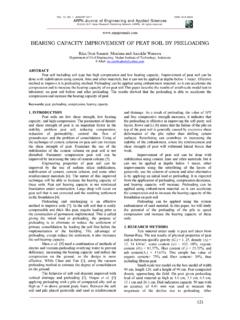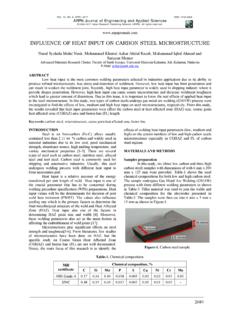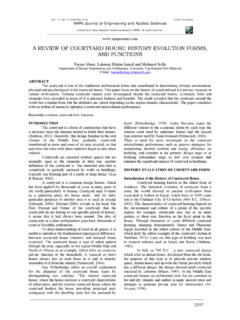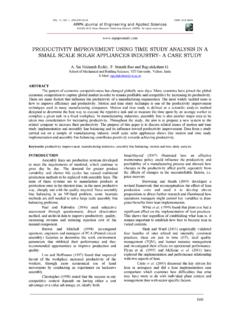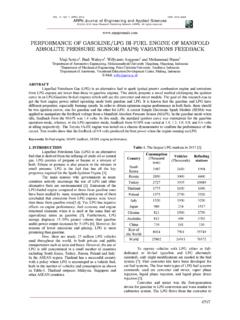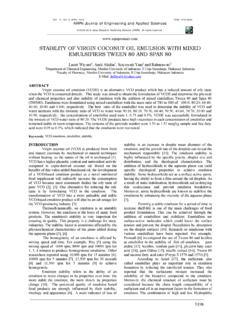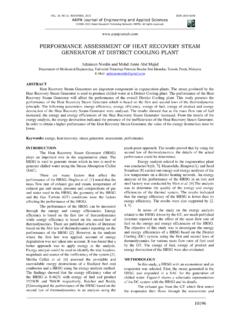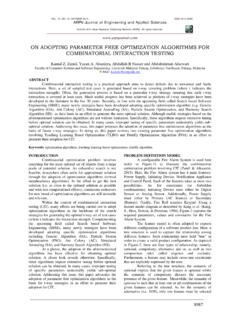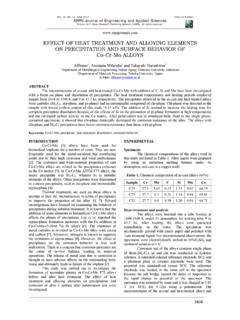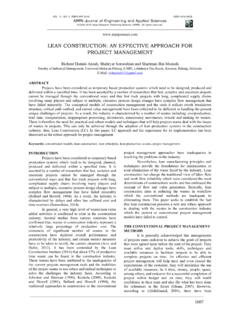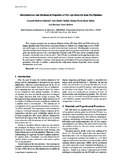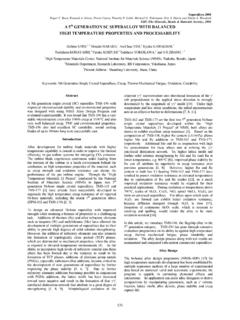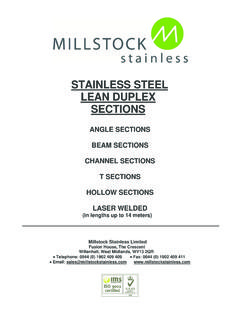Transcription of EFFECT OF WELDING HEAT INPUT ON MICROSTRUCTURE …
1 VOL. 10, NO 20, NOVEMBER, 2015 ISSN 1819-6608 ARPN Journal of Engineering and Applied Sciences 2006-2015 Asian Research Publishing Network (ARPN). All rights reserved. 9487 EFFECT OF WELDING HEAT INPUT ON MICROSTRUCTURE AND MECHANICAL PROPERTIES AT COARSE GRAIN HEAT AFFECTED ZONE OF ABS GRADE A STEEL Wan Shaiful Hasrizam Wan Muda1, Nurul Syahida Mohd Nasir2, Sarizam Mamat2 and Saifulnizan Jamian3 1 Department of Mechanical and Production, Institut Latihan Perindustrian, Kawasan Perindustrian Gebeng, Kuantan, Pahang, Malaysia 2 Faculty of Earth Science, Universiti Malaysia Kelantan, Jeli, Kelantan, Malaysia 3 Faculty of Mechanical and Manufacturing Engineering, Universiti Tun Hussein Onn, Parit Raja, Batu Pahat, Johor, Malaysia E-Mail.
2 ABSTRACT The fabrication and construction of structures used in the offshore and marine industries are made according to the international code and standard requirements to ensure the quality and to extend the life span. Proper material selection needs to be carried out to achieve proper function and to reduce the cost. The American Bureau of Shipping (ABS) Grade A steel is one of the huge materials used in the marine industries. The study has been carried out to scrutinize the EFFECT of WELDING heat INPUT to the distribution of MICROSTRUCTURE formation and its mechanical properties at coarse grain heat affected zone (CGHAZ) of the ABS Grade A steel. Three heat INPUT combinations which designated as low heat ( kJ/mm), medium heat ( kJ/mm) and high heat ( kJ/mm) have been used to the weld specimen by using flux cored arc WELDING (FCAW) process.
3 The MICROSTRUCTURE formation at CGHAZ was consisting of grain boundary ferrite (GBF), Widmanstatten ferrite (WF) and pearlite (P). Significant grain coarsening was observed at the CGHAZ of all the joints, and it was found that the extent of grain coarsening at CGHAZ has also increased along with the heat INPUT . The results of the mechanical investigation indicated that the joints made by using low heat INPUT exhibit higher hardness and impact toughness value than those welded with medium and high heat INPUT . It can be concluded that higher heat INPUT can cause the expansion towards the MICROSTRUCTURE s grain size, but will lead to lower hardness and affect the toughness value. Keywords: heat INPUT , MICROSTRUCTURE , hardness, toughness, CGHAZ. INTRODUCTION In practice, the most essential properties of the steels used in marine and offshore structures are good toughness characterized by Charpy V-notch impact test, and tensile strength of the weld joints which made by WELDING procedures.
4 Due to its high heat inputs during the joining process, the coarse grain heat affected zone (CGHAZ) adjacent to the fusion line of this steel grade represents a region of pronounced low toughness. This is often revealed by fracture toughness tests, which are being increasingly used in marine structural applications. Heat INPUT is known to be one of the factors that influence the formation of MICROSTRUCTURE at HAZ. The formation of MICROSTRUCTURE especially martensite, bainite and martensite-austenite (MA) constituent potent to affect the toughness of the HAZ, thus lead to the cracking of HAZ just after the WELDING work. In order to control this problem, it is crucial to understand how the heat INPUT affects a MICROSTRUCTURE and relate it to mechanical properties of the material.
5 To date, there are many researches have been done to study the effects of heat INPUT and relate it to the formation of MICROSTRUCTURE and its mechanical properties. However, there are still less studies done regarding to the weldments since the previous studies are merely based on simulated HAZ. Thus, this study aims to characterize and appraise the behavior of MICROSTRUCTURE transformation at CGHAZ and its correlation to the heat INPUT . The use of flux core arc WELDING (FCAW) process during sample preparation reflects the current practice by industry to weld the steel structure. In addition, the elucidation of the transformation behavior can be obtained through the optical MICROSTRUCTURE technique and its properties through the mechanical testing.
6 The outcome of this study may provide good information in determining the WELDING parameter during WELDING procedure specification (WPS) preparation. The gained knowledge could embark a further research in investigating the optimum heat INPUT range to be set during WELDING work, thus improve the quality of the weldments. LITERATURE REVIEW The MICROSTRUCTURE in the HAZ is largely dependent upon the heat INPUT and its location or distance from the fusion boundary. As the distance from the fusion boundary increases, the peak temperature that the base metal MICROSTRUCTURE is exposed to decreases. A high heat INPUT increases the time that the base metal MICROSTRUCTURE is exposed to the peak temperature. The peak temperature in the HAZ does not reach the melting point of the carbon steel [1, 2].
7 Generally, the HAZ is the base metal underlying the weld which has been heated to the temperatures above the iron-iron carbide (Fe-FeC3) metastable phase diagram A1 line (723 oC) temperature VOL. 10, NO 20, NOVEMBER, 2015 ISSN 1819-6608 ARPN Journal of Engineering and Applied Sciences 2006-2015 Asian Research Publishing Network (ARPN). All rights reserved. 9488 and below the solidus temperature, typically 1495 oC as shown in Figure-1. Figure-1. Relationship between heat affected zone and corresponding temperature [1].
8 Weld area can be defined as the area that includes weld metal and HAZ. The HAZ in metal can be divided into four main areas such as CGHAZ, fine grained supercritical HAZ (FGHAZ), intercritical HAZ (ICHAZ) and subcritical HAZ (SCHAZ). Among these, CGHAZ is the most affected area during WELDING process due to rapid cooling which caused hardening which in turn can be the main factor of cleavage cracking [1]. In [3] has investigated the effects of coarse initial grain size on the MICROSTRUCTURE , hardness and toughness of the weld metal and HAZ of low carbon steel. From the results of the toughness tests, it can be seen that the weld metal of coarse initial grain sized specimens and original specimens exhibited nearly the same toughness values with the same heat INPUT , whereas different HAZ toughness values were obtained with the same heat INPUT .
9 Maximum toughness of HAZ of the coarse initial grain sized specimen was achieved with a high INPUT , while maximum toughness of original specimen was obtained with a medium heat INPUT . As a result, considering the heat INPUT , it was observed that the coarse initial grain size had a great influence on the MICROSTRUCTURE , hardness and toughness of HAZ of low carbon steel. The MICROSTRUCTURE in weld metal changed from martensite and bainite to grain boundary ferrite, Widmanstaten ferrite, acicular ferrite and pearlite, and the MICROSTRUCTURE in GCHAZ changed from martensite, bainite, pearlite and polygonal ferrite to pearlite and polygonal ferrite. The amount of pearlite in GCHAZ increased at the expense of martensite and bainite. Meanwhile, in [4] investigated the EFFECT of MICROSTRUCTURE on hardness and toughness of low carbon welded steel by using inert gas WELDING .
10 Results showed that by raising the voltage from 20 V to 30 V, the grain size number decreased from to It was also observed that high heat INPUT and rapid cooling rates in the weld metals produced fine grained polygonal ferrites at ambient temperature. High heat INPUT led to grain coarsening which was more pronounced in the HAZ, as well as reducing the impact energy and toughness. Elevation of heat INPUT reduced the hardness in the HAZ, for instance raising the heat INPUT from 5 to 8 kJ/cm which decreased the hardness from 160 to 148 HBN. This is considered to attribute a reduction in the density of dislocations and microstructural coarsening. METHODOLOGY American Bureau of Shipping (ABS) Grade Asteel in the form of a 6 mm thick plate was chosen for the study.
